 |
|
|
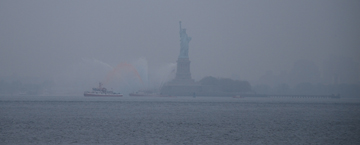 |
Click here to see the Statue of Liberty later in the morning, once the fog clears. |
0745 hours
Current Position: Anchored at Bay Ridge Flats.
Latitude: 40˚ 39.85'
Longitude: 074˚ 01.55'
Day Two of our Voyage of Discovery.
After our long, late day of activity yesterday, we allow ourselves a leisurely start to the morning. After rising at 0745 hours -- the equivalent to "sleeping in" on board the Half Moon, we enjoy breakfast and the students spend an hour writing in their journals.
Temperatures are cool but not uncomfortable, but the weather front continues to close in. We rise to see New York Harbor cloaked in dense fog.
|
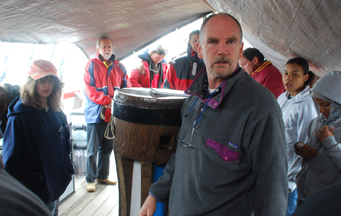
1045 hours
Captain Reynolds gathers the student crew around the capstan for a series of orientation briefings, forming the proper start of our day.
|
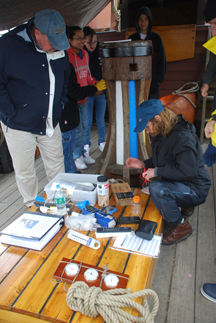
1100 hours
The students split up into three groups of four to receive individual attention. For half an hour, Dr. Jacobs, Mr. Chalker, and Mr. van Aken provide one group of students with a preliminary introduction to all of the various scientific instruments the students will be using for their presenations. Although each team of students will focus on a specific area of study, and will thus only need a few instruments, each student will have the opportunity to take readings in every field.
|
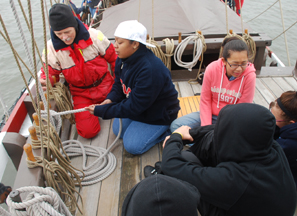
Meanwhile, up on the fore deck, Mr. Moore and Mr. Hansen introduce a second group of students to line handling, an essential element of shipcraft.
|
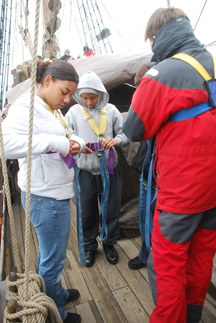
Lastly, to either side of the main mast, Mr. Morel and Mr. Schuijer lead the third group of students through safety harness training and hang tests, preparing them to work the rig (if they so choose). |
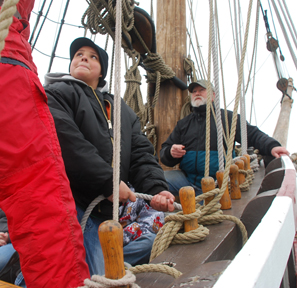
1130 hours
After half an hour, the teams of students rotate to another station. Additional students learn how to belay a line...
|
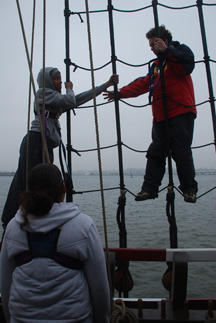
...how to utilize three points of contact to safely climb aloft...
|
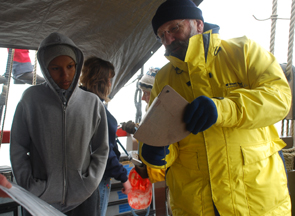
...and how to use a quadrant, among other basic principles.
|
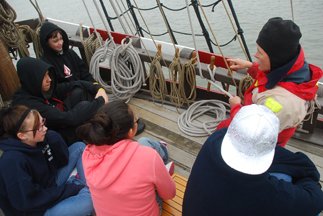
Half an hour later, the teams rotate again. After an hour and a half of orientation, all of the students have received training in all three fields.
|
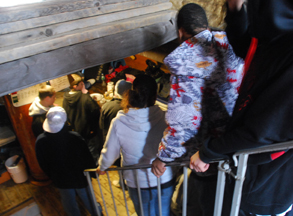
1230 hours
As we conclude our orientation sessions, Mr. Gorter serves lunch on the orlop deck. Today, the crew have their pick of hot dogs and/or quiche.
|
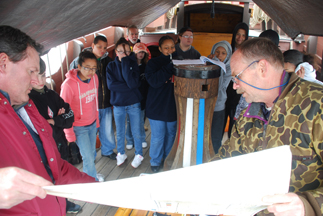
1330 hours
After lunch, Captain Reynolds and Mr. Linehan lead the students through another orientation session, this time teaching them the basics of how to read a chart.
|
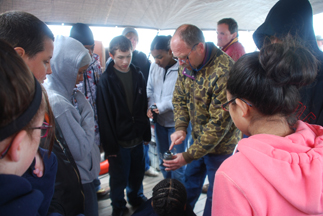
They then demonstrate the basics of how to use lines of position to determine their location on the chart.
|
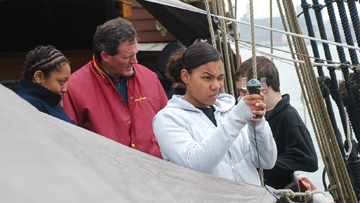
This is just an introduction to familiarize the students with the concepts and the instruments; they'll have more opportunities later to actually chart their position. In fact, Jacob and Daniella's research project centers on lines of position, and will involve the entire crew.
|
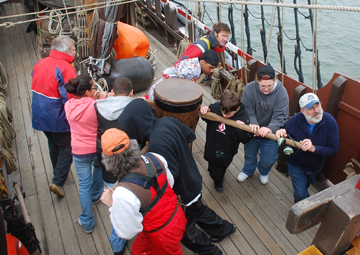
1430 hours
The fog is lifting and the tide is turning in our favor. Time has come to weigh anchor and begin our journey up the Hudson River. While one team of senior and student crew members work below on the orlop deck to guide the anchor rode (line), another large team walks the capstan. This massive winch uses mechanical advantage to combine the strength of everyone using it.
|
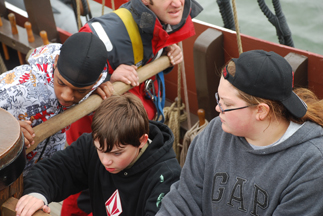
Despite having the combined strength of ten people, it's still intense, heavy work. In fact, it's a little extra intense today...
|
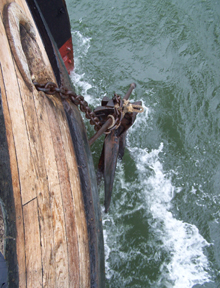
The capstan team breaks the anchor free from the harbor's bottom and pulls it to the surface. As the anchor rises into view, however, we discover that it has somehow entangled itself in its own chain and is now precariously hanging upside down. This is not an unprecented situation, however, and our crew knows what to do. With a little extra patience, a bit of elbow grease, and a great deal of caution, the senior crew members secure the anchor so it cannot fall, free the tangled chain, and safely turn the anchor upright. The anchor is soon securely lashed to the starboard fore channel, right where it belongs.
|
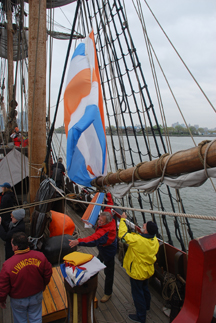
1530 hours
We are now underway and raise our flags. This multicolored flag represents the Seven Provinces of the Netherlands (as they existed in 1609); the original Half Moon would have proudly flown a flag just like this.
|
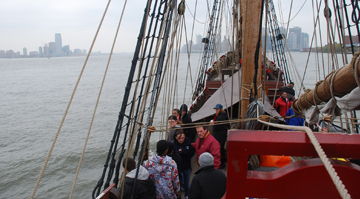
Unfortunately, we are now motoring directly into the face of strong, steady, northerly winds. As we enter the mouth of the Hudson River, it's questionable whether we'll have an opportunity to sail today.
|
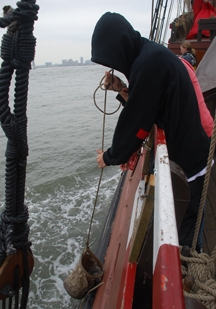 |
Mouse over to collect the first water sample. |
As we get underway, Muhammad and Thwe-Thwe get an early start on their research project. They will be charting water salinity from New York Harbor all the way to Athens, NY, so they take their first sample and store it for future analysis.
|
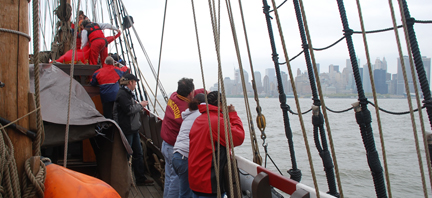
As we motor north, retracing our path, the crew enjoys the opportunity to sight-see the daytime skyline of Manhattan.
|
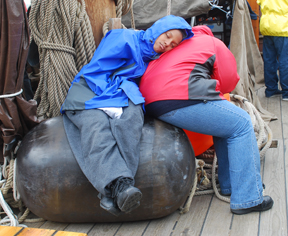
1615 hours
Our soft, inflatable fenders prove an irresistable target for off-duty crew members looking for a catnap. The more the merrier!
|
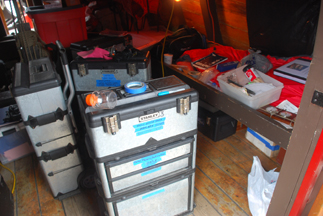
1700 hours
In 1609, the Half Moon's fo'c'sle (short "for forecastle") was used as the ships galley. On other ships and in other eras, the fo'c'sle was used to house the crew. On the Replica Ship Half Moon, the fo'c'sle spends its days as our central ecological laboratory.
|
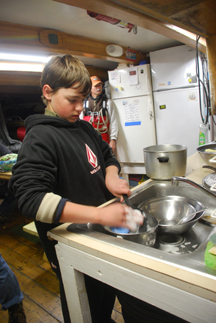
Most of the action is taking place below decks. On galley duty, Jacob dutifully cleans the dishes from lunch. Later on, we'll serve pretzels, peanuts, and popcorn for snacks.
|
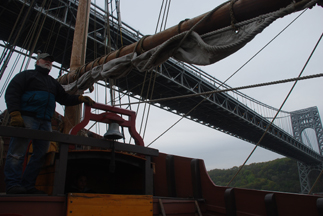
1745 hours
We pass under George Washington Bridge, leaving Manhattan behind us.
|
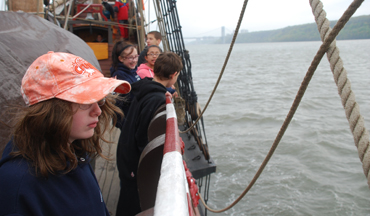
1800 hours
Students still have time to take in the scenery, but by now they tend to cluster in areas of the deck sheltered by the wind.
|
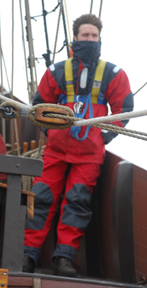
Although the day itself is not particularly cold (our shipboard thermometer reads a temperature in the mid-50s F), the northerly wind creates a bitter chill, particularly on the upper decks, which have little protection. The Quarter deck officers navigating the ship find themselves particularly in need of bundling up, but they brave it out. |
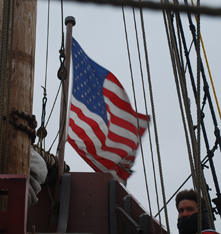 |
Mouse over to watch the whipping winds. |
Some crew members estimate that the air can feel ten degrees warmer just by climbinb down out of the wind. Were we heading south, on the other hand, this would be envigorating weather for sailing.
|
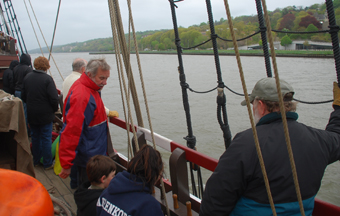
1845 hours
We're arriving at our destination for the night -- the waterfront of Yonkers, the very spot where our student crew came aboard just yesterday.
|
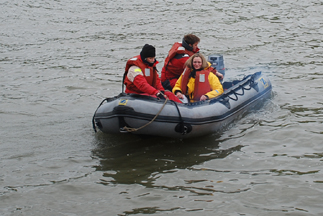
Since Ms. Giles is disembarking anyway, she offers to make a quick run into town for a few supplies, taking Yonkers native Mr. Moore with her as a guide. While they're gone, we weigh our options: Dock here in Yonkers, or set anchor across the channel, just off Alpine? Ultimately, we decide to dock rather than anchor tonight.
|
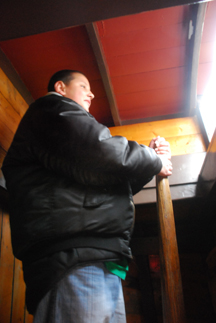
1930 hours
Special congratulations today go to Keith, who personally manned the helm for a marathon two-and-a-half-hour session. At 1600 hours, he initially volunteered to substitute at the helm for a fellow Port Watch member who was working with Dr. Jacobs on her science project, with his own shift following immediately thereafter. However, by the time his own hour at the whipstaff was up, we were the thick of docking procedures, so he maintained his post until the ship was finally secure and the whipstaff safely lashed.
|
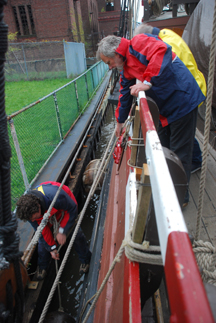
Once the Half Moon is docked, the crew applies chafing gear and the father-and-son Morel team adjust our fenders. Just like the fenders help protect a car from collision damage, these hanging objects prevent the ship from grinding against its moorings.
|
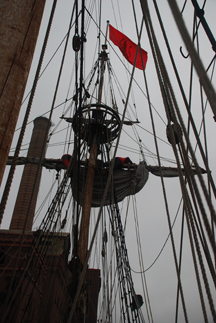
Meanwhile, Captain Reynolds and several members of the senior crew climb aloft to furl the sails for the night. Tomorrow, however, we think we may have an opportunity to set sail!
2000 hours
Dinner is served on the orlop deck! Tonight's meal includes beef stew, mashed potatoes, mixed vegetables, salad, and even some special Dutch hors d'oeuvres.
Ms. Giles and Mr. Moore return from their supply run during dinner. After sitting down to eat, Ms. Giles bids us farewell, returning to her family as planned. She'll be in Albany to greet us as we arrive on Thursday.
2100 hours
Captain Reynolds convenes an anchor watch briefing on the weather deck. We aren't at anchor, but the students are still needed to monitor our mooring lines overnight. After the brief meeting, the students return to their bunks on the orlop deck to update their journals and rummage their gear. We expect steady rain to pass into the region around midnight and persist until midday, so the students will want to keep their raingear handy.
2200 hours
Lights out. The students' first full day on board the Half Moon comes to a peaceful end. We plan on rising bright and early tomorrow morning to catch the flow tide as we continue upriver.
|
| |
|
|
|

































